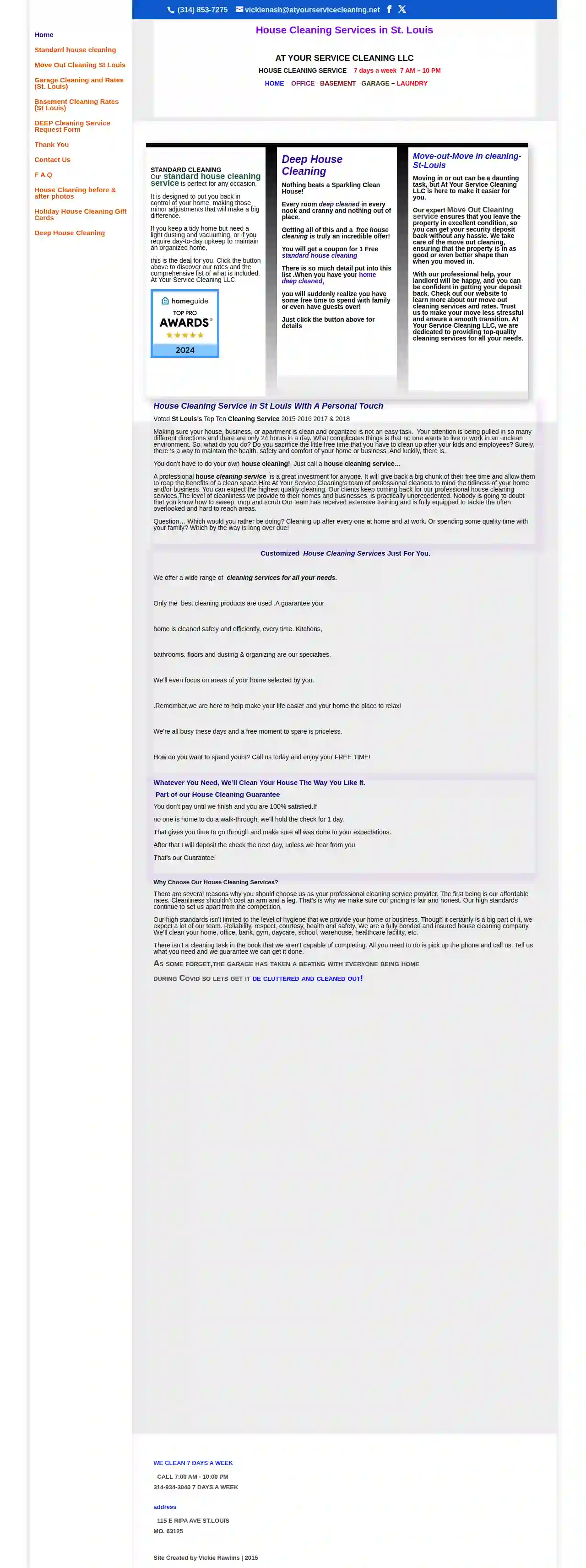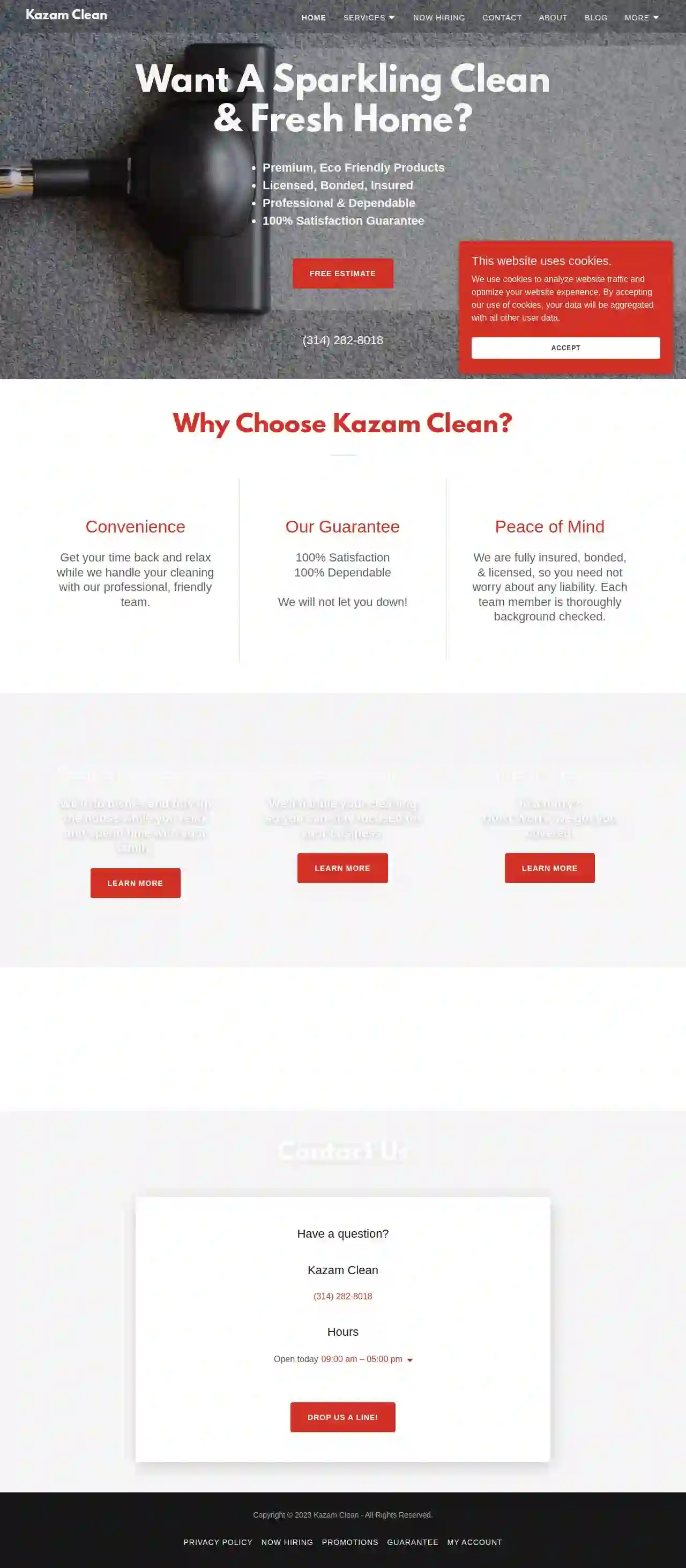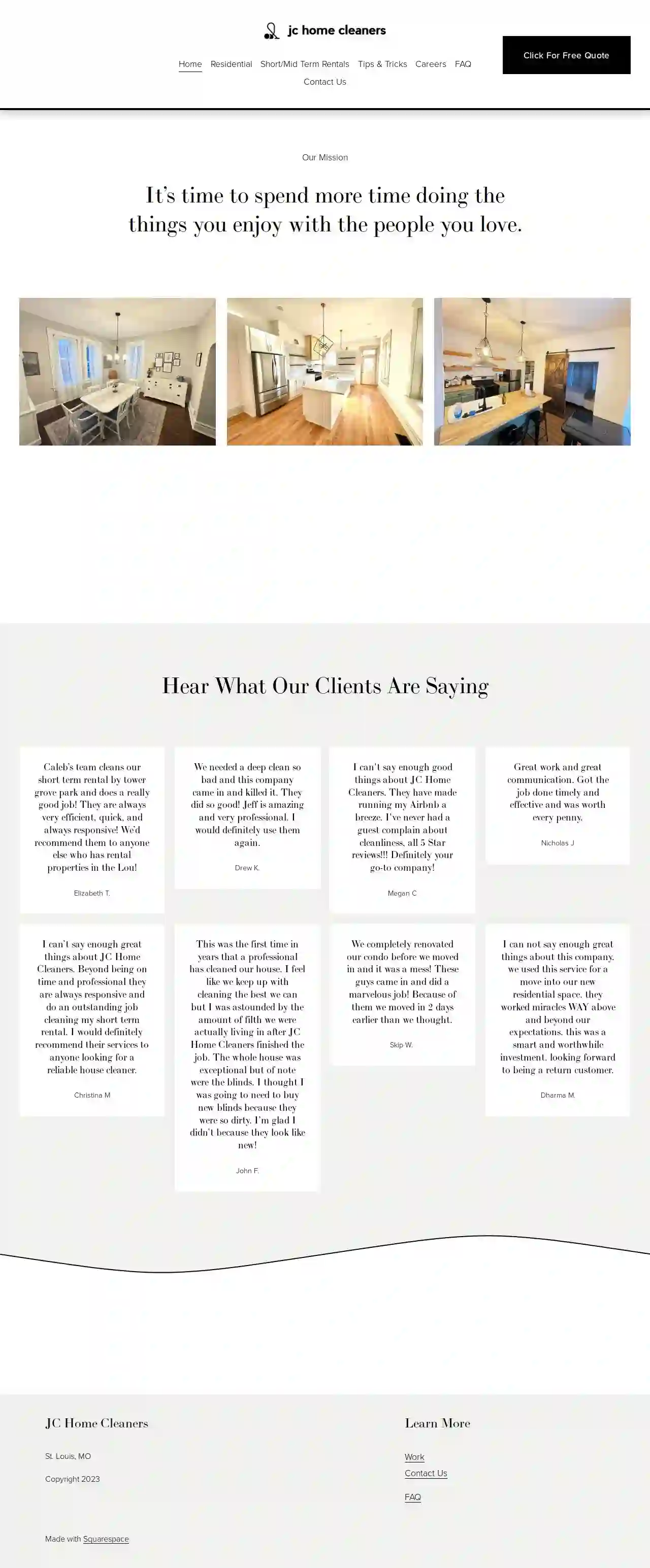Cleaning Services California
Find the best Cleaning Companies in California
Receive multiple Home Cleaning quotes for your project today! Compare profiles, reviews, accreditations, portfolio, etc... and choose the best deal.

The Clean-Tech Company
3.7161 reviews211 South Jefferson, Saint Louis, USAt Clean-Tech Company, we're dedicated to creating a positive impact on your business. With over 60 years of experience, we provide customized solutions for commercial, medical, educational, and industrial facilities. Our team becomes a seamless extension of yours, ensuring quality assurance and a commitment to green cleaning. We believe in cleaning with a conscience, using environmentally certified products and sustainable methods to reduce exposure to chemicals and improve air quality. Our mission is to create safe environments that enrich lives and facilitate success.
- Services
- Why Us?
- Gallery
Get Quote
Coverall
4.226 reviews680 Craig Rd Suite 260, Creve Coeur, 63141, USAt Coverall, we keep up with the advances in chemistry and technology to provide your commercial facility with a healthier, more effective cleaning solution. With years of experience and new techniques, we take great pride in establishing a higher standard for our janitorial and commercial cleaning services in St. Louis, MO, and surrounding areas. Our St. Louis team is prepared to deliver high-quality cleaning services to your business. We provide high-quality commercial cleaning solutions for the following:
- Services
- Why Us?
- Gallery
Get Quote
At Your Service Cleaning LLC
4.535 reviewsSt. Louis, US- Services
- Why Us?
- Gallery
Get Quote
Cleaning Concepts of St Louis
4.9Brentwood, St. Louis, MO, 8837 Manchester Road, 63144, USCleaning Concepts of St. Louis is a professional house cleaning and maid service that has been serving the St. Louis area since 1991. They offer routine house cleaning, deep cleaning, move in/move out cleaning, and commercial cleaning services. Their team is composed of highly trained and trusted individuals who are dedicated to providing exceptional cleaning services. They are fully accredited and insured, and they guarantee customer satisfaction with their 100% satisfaction guarantee.
- Services
- Why Us?
- Accreditations
- Our Team
- Testimonials
- Gallery
Get Quote
River City Cleaning - Commercial Cleaning Solutions
51 reviewsSt. Louis, USAt River City Cleaning, we are committed to taking care of your cleaning needs. We proudly serve businesses across St. Louis, MO, offering expert cleaning solutions to meet your unique requirements. With our comprehensive list of professional office cleaning services, we can handle anything from nightly office cleaning to routine bathroom cleaning. Our team is dedicated to providing excellent communication and reliable points of contact, ensuring your satisfaction with our services. Our purpose is to provide a reliable cleaning solution for your facility, and we achieve this through our strategy and commitment to excellence. We have an extensive list of cleaning services in several industries, including office buildings, religious buildings, fitness centers, funeral homes, apartment complexes, property management, real estate, banks, financial institutions, and hospitality.
- Services
- Why Us?
- Gallery
Get Quote
Kazam Clean, LLC
4.88 reviews123 Clean St, St Louis, MO, St. Louis, 63101, USKazam Clean is a maid service company currently servicing the St Louis, MO area, focused on rendering exceptional cleaning and customer service to our clients. Our mission is to become the most trusted, respected, and reliable cleaning company in St Louis. We are committed to providing the highest quality maid cleaning service available by exceeding the expectations of our clients through continuous improvements in Quality, Services, and Productivity. Our core values include Integrity, Reliability, Caring, Excellence, and Innovation. We aim to deliver the best quality experience with regards to our cleaning and our customer service.
- Services
- Why Us?
- Accreditations
- Our Team
- Testimonials
Get Quote
JC Home Cleaners
551 reviewsSt. Louis, US- Services
- Why Us?
- Gallery
Get Quote
On The Spot Cleans
57 reviewsSt. Louis, USOn The Spot Cleans is a reliable and professional house cleaning service provider in St. Louis and Dallas. We offer a range of cleaning services tailored to meet your unique needs, from regular house cleaning to deep cleaning and moving house cleaning. Our team of dedicated professionals is committed to excellence and brings reliability and friendliness to every cleaning session. Our services are designed to fit seamlessly into your lifestyle, providing a hassle-free and spotless experience. We pride ourselves on being your trusted house cleaning partner, and our clients love our attention to detail and professionalism.
- Services
- Why Us?
- Accreditations
- Testimonials
- Gallery
Get Quote
WashStudio (formerly Soulard Soap Laundromat & Cleaners)
4.5284 reviewsSt. Louis, MO, United States, 1800 S. 9th Street, 63104, USWashStudio is your neighborhood's trusted partner for top-notch laundry services. With a commitment to convenience, cleanliness, and customer satisfaction, we take the hassle out of laundry day. Our state-of-the-art facilities feature modern, efficient machines and a welcoming atmosphere, making laundry a breeze. Plus, our laundry pickup and delivery service offers unparalleled ease for busy individuals. At Wash Studio, we're dedicated to delivering fresh, clean clothes and a stress-free laundry experience, ensuring you have more time for what matters most. Discover the difference with WashStudio, your local laundry experts.
- Services
- Why Us?
- Accreditations
- Our Team
- Testimonials
- Gallery
Get Quote
Two Ladies & A Bucket
4.6178 reviewsSt. Louis, USCreating Free Time for Busy People. Two Ladies & A Bucket provides professional house cleaning services throughout St. Louis, MO and nearby communities. Call (314) 229-1736. Online Estimates. Cleaning Services Trusted in St. Louis Since 2005. A clean home is a healthy home. In less time and without the headaches, you can have an experienced cleaning team regularly clean your home. You want a home that ensures your family health is not impacted by hidden dust, mold or germs. Making this happen requires consistency, the right tools and products, the time, energy and a plan to make sure all the visible and hidden parts of your house are clean. An understandably difficult job. The Two Ladies & a Bucket team, come into your home professionally, prepared and with purpose. We provide an impeccable level of cleaning with consistency, so that your house remains to be a healthy and welcome environment for family and friends. Your cleaning tasks are tackled from the front of your house to the nooks and crannies, by our on-time team of professionals trained to locate and remove dirt and germs from all locations in your home. We Are Super Pet-Friendly! We have a 100% FREE up your time guarantee! If you’re not completely satisfied, we’ll come back within 48 hours to make things right! Yes, We’re Pet-Friendly! Your Personal Cleaning Team Two Ladies & A Bucket home cleaning services is based out of St. Louis Missouri. Our continued success is because of our loyal customers who enjoy our attention to detail, and courteous service, and refer us to their friends and neighbors. New customers will be hooked once they experience our staff’s professional attitude and they’re spotless home! We are a fully bonded and insured cleaning company, serving the St. Louis Metro area, including the counties of St. Charles and Jefferson County. Call or contact us if you have any questions about our service area. We will provide you with the details of the services we provide or schedule a complimentary evaluation of your home and it’s unique requirements. We love referrals. Referrals are the highest compliment we can receive from our clients. We appreciate your trust and confidence in our services. If our current client refers a new recurring client to us, then our current client receives a FREE cleaning! If the new client that was referred is a one-time cleaning the current client will receive $25.00 off their next cleaning fee. Referral Program 5-Star Cleaning Services. For immediate service, please call: (314) 229-1736. Our office hours are Monday – Friday, 8:00 am – 5:00 pm. Instant Online Estimates. Proudly serving St. Louis, MO and nearby communities: Affton, Antonia, Arnold, Ballwin, Barnhart, Benton Park, Brentwood, Central West End, Chesterfield, Clayton, Columbia, IL, Crestwood, Creve Coeur, Des Peres, Ellisville, Eureka, Fenton, Frontenac, Glendale, Green Park, High Ridge, House Springs, Imperial, Jefferson County (parts), Kirkwood, Ladue, Lemay, Manchester, Maplewood, Maryland Heights, Mehville, Oakland, Oakville, Olivette, Richmond Heights, Rock Hill, Soulard, South City, South County, South Hampton, St. Louis, Sunset Hills, The Hill, Tower Grove, Town & Country, University City, Valley Park, Waterloo, IL, Webster Groves, West County, Wildwood.
- Services
- Why Us?
- Our Team
- Gallery
Get Quote
Over 60,241+ Janitorial Services in our network
Our janitorial pros operate in California & surrounding areas!
CleaningMatch has curated and vetted Top Cleaning Contractors in and around California. Find a top & reliable business today.
Frequently Asked Questions About Cleaning Services
- Using the wrong cleaning products: Certain cleaning products are unsuitable for specific surfaces. Using abrasive cleaners on delicate surfaces can cause scratches or discoloration.
- Not reading product instructions: Always read and follow the instructions on cleaning products to ensure proper usage and avoid potential hazards.
- Using dirty cleaning tools: Dirty cloths, sponges, and mops can spread germs and dirt instead of cleaning them. Rinse and sanitize your cleaning tools regularly.
- Skipping ventilation: Proper ventilation is essential when using cleaning products, especially those with strong fumes. Open windows and doors to allow fresh air circulation.
- Not allowing sufficient drying time: After cleaning, allow surfaces to dry completely to prevent mold and mildew growth, particularly in humid areas like bathrooms.
- Ignoring clutter: Clutter makes cleaning more difficult and time-consuming. Declutter regularly to maintain a cleaner and more organized home.
- Ventilation: Improve ventilation by opening windows, turning on the exhaust fan, and using a dehumidifier to reduce moisture levels.
- Bleach Solution: Mix one cup of bleach with one gallon of water. Wear gloves and eye protection when handling bleach. Apply the solution to the affected area, let it sit for 10-15 minutes, then scrub with a brush and rinse thoroughly.
- Vinegar Solution: For a milder alternative, mix equal parts water and vinegar. Apply to the moldy area, let it sit for an hour, then scrub and rinse.
- Baking Soda Paste: Make a paste of baking soda and water, apply to the moldy area, let it dry, then scrub and rinse. Baking soda helps remove stains and deodorize.
- Commercial Mold and Mildew Remover: Use a commercial mold and mildew remover according to the product instructions.
- Blot, don't rub: When treating fresh stains, blot with a clean cloth or paper towel to absorb as much of the stain as possible. Rubbing can spread the stain and damage carpet fibers.
- Club Soda: For spills like wine or coffee, pour club soda on the stain, let it fizz, then blot with a clean cloth. Repeat if needed.
- Vinegar Solution: Mix equal parts white vinegar and water, apply to the stain, and blot. Vinegar helps remove stains and odors.
- Baking Soda Paste: Make a paste with baking soda and water, apply to the stain, let it dry, then vacuum. Baking soda absorbs odors and lifts stains.
- Commercial Carpet Cleaner: : Use a commercial carpet cleaner according to the instructions. Choose a cleaner specifically designed for the type of stain you're dealing with.
- Professional Carpet Cleaning: For stubborn or deeply set stains, consider hiring a professional carpet cleaning service. They have specialized equipment and expertise in stain removal.
- Experience and a proven track record: Choose companies with a solid history of providing quality cleaning services.
- Positive customer reviews and testimonials: Check online reviews and ratings to gauge customer satisfaction.
- Licensed and insured professionals: Ensure the company has the necessary licenses and insurance to protect you from liability.
- Clear and transparent pricing: Obtain detailed quotes and compare prices from multiple companies.
- Good communication and responsiveness: Choose a company that communicates clearly, responds promptly, and addresses your concerns.
What are some common cleaning mistakes to avoid?
By avoiding these common cleaning mistakes, you can improve your cleaning efficiency and achieve better results.
How do I remove mold and mildew from my bathroom?
Always test any cleaning solution on a small, inconspicuous area first. After cleaning, take steps to prevent future mold growth by addressing moisture issues, such as fixing leaks and improving ventilation.
How can I get rid of tough stains on carpets?
Always test any cleaning solution on a small, inconspicuous area of the carpet first to ensure it doesn't cause discoloration or damage.
How do I find a good cleaning service?
Utilize online directories like CleaningMatch to find and compare qualified cleaning services in your area.
What are some common cleaning mistakes to avoid?
- Using the wrong cleaning products: Certain cleaning products are unsuitable for specific surfaces. Using abrasive cleaners on delicate surfaces can cause scratches or discoloration.
- Not reading product instructions: Always read and follow the instructions on cleaning products to ensure proper usage and avoid potential hazards.
- Using dirty cleaning tools: Dirty cloths, sponges, and mops can spread germs and dirt instead of cleaning them. Rinse and sanitize your cleaning tools regularly.
- Skipping ventilation: Proper ventilation is essential when using cleaning products, especially those with strong fumes. Open windows and doors to allow fresh air circulation.
- Not allowing sufficient drying time: After cleaning, allow surfaces to dry completely to prevent mold and mildew growth, particularly in humid areas like bathrooms.
- Ignoring clutter: Clutter makes cleaning more difficult and time-consuming. Declutter regularly to maintain a cleaner and more organized home.
By avoiding these common cleaning mistakes, you can improve your cleaning efficiency and achieve better results.
How do I remove mold and mildew from my bathroom?
- Ventilation: Improve ventilation by opening windows, turning on the exhaust fan, and using a dehumidifier to reduce moisture levels.
- Bleach Solution: Mix one cup of bleach with one gallon of water. Wear gloves and eye protection when handling bleach. Apply the solution to the affected area, let it sit for 10-15 minutes, then scrub with a brush and rinse thoroughly.
- Vinegar Solution: For a milder alternative, mix equal parts water and vinegar. Apply to the moldy area, let it sit for an hour, then scrub and rinse.
- Baking Soda Paste: Make a paste of baking soda and water, apply to the moldy area, let it dry, then scrub and rinse. Baking soda helps remove stains and deodorize.
- Commercial Mold and Mildew Remover: Use a commercial mold and mildew remover according to the product instructions.
Always test any cleaning solution on a small, inconspicuous area first. After cleaning, take steps to prevent future mold growth by addressing moisture issues, such as fixing leaks and improving ventilation.
How can I get rid of tough stains on carpets?
- Blot, don't rub: When treating fresh stains, blot with a clean cloth or paper towel to absorb as much of the stain as possible. Rubbing can spread the stain and damage carpet fibers.
- Club Soda: For spills like wine or coffee, pour club soda on the stain, let it fizz, then blot with a clean cloth. Repeat if needed.
- Vinegar Solution: Mix equal parts white vinegar and water, apply to the stain, and blot. Vinegar helps remove stains and odors.
- Baking Soda Paste: Make a paste with baking soda and water, apply to the stain, let it dry, then vacuum. Baking soda absorbs odors and lifts stains.
- Commercial Carpet Cleaner: : Use a commercial carpet cleaner according to the instructions. Choose a cleaner specifically designed for the type of stain you're dealing with.
- Professional Carpet Cleaning: For stubborn or deeply set stains, consider hiring a professional carpet cleaning service. They have specialized equipment and expertise in stain removal.
Always test any cleaning solution on a small, inconspicuous area of the carpet first to ensure it doesn't cause discoloration or damage.
How do I find a good cleaning service?
- Experience and a proven track record: Choose companies with a solid history of providing quality cleaning services.
- Positive customer reviews and testimonials: Check online reviews and ratings to gauge customer satisfaction.
- Licensed and insured professionals: Ensure the company has the necessary licenses and insurance to protect you from liability.
- Clear and transparent pricing: Obtain detailed quotes and compare prices from multiple companies.
- Good communication and responsiveness: Choose a company that communicates clearly, responds promptly, and addresses your concerns.
Utilize online directories like CleaningMatch to find and compare qualified cleaning services in your area.